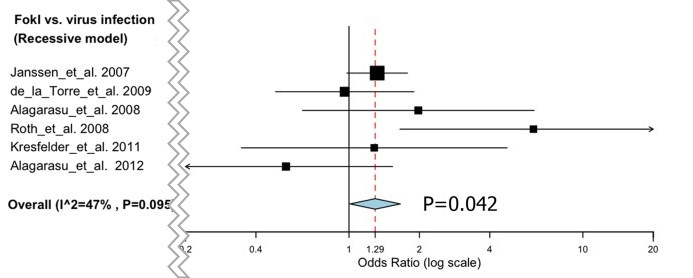Risk of enveloped virus infection is increased 50 percent if poor Vitamin D Receptor - meta-analysis
Vitamin D Receptor polymorphisms and risk of enveloped virus infection: A meta-analysis
Gene. 2018 Dec 15;678:384-394. doi: 10.1016/j.gene.2018.08.017. Epub 2018 Aug 6.
Laplana M1, Royo JL2, Fibla J3.
1 Dept of Basic Medical Sciences, University of Lleida and Institute of Biomedical Research of Lleida (IRBLleida), Lleida, Spain. marinalaplana@cmb.udl.cat.
2 Dept of Basic Medical Sciences, University of Lleida and Institute of Biomedical Research of Lleida (IRBLleida), Lleida, Spain.
3 Dept of Basic Medical Sciences, University of Lleida and Institute of Biomedical Research of Lleida (IRBLleida), Lleida, Spain. joan.fibla@cmb.udl.cat.
📄 Download the PDF from Sci-Hub via VitaminDWiki


INTRODUCTION:
Vitamin-D plays a role regulating the immune response against to viral infection. In this sense, vitamin-D deficiency may confer increased susceptibility to enveloped virus infection such as
HIV,
Hepatitis,
Dengue and
Respiratory Syncytial virus infection, among others.
Vitamin D activity is mediated by its receptor (VDR), which acts as a transcription factor modulating the expression of genes triggering the response against viruses. To date, six major VDR polymorphisms (Cdx, A1012G, FokI, BsmI, ApaI and TaqI) have been studied in the context of viral infection susceptibility. Reported studies show controversial results probably due to statistical lack of power and population genetic differences.
AIMS: To do a systematic review of the published data and to perform a meta-analysis examining the role of six VDR polymorphisms on infection susceptibility to enveloped virus.
RESULTS: From all markers and virus considered an association of FokI polymorphism with RSV infection emerges as significant. The worldwide distribution of risk T-allele reveals a lower prevalence in African populations that runs parallel with the relative lower incidence of RSV-associated severe ALRI in children <1 year described in African samples.
CONCLUSION: The results disclose FokI polymorphism as a relevant variant capturing the association of VDR polymorphisms with viral infection.
